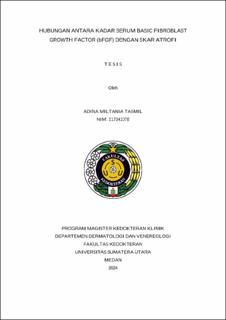Hubungan antara Kadar Serum Basic Fibroblast Growth Factor (bFGF) dengan Skar Atrofi
Correlation between Basic Fibroblast Growth Factor (bFGF) and Atrophic Scar

Date
2024Author
Tasmil, Adina Miltania
Advisor(s)
Putra, Imam Budi
Jusuf, Nelva Karmila
Metadata
Show full item recordAbstract
Background: Atrophic scars are scars that form depressions compared to the surrounding skin surface due to damage to collagen, fat, or other tissues under the skin. Clinically, atrophic scars classically present as a depression or loss of tissue in the skin. Underlying disorders can cause atrophic scars, such as inflammation, infection, and trauma. Basic fibroblast growth factor (bFGF) is known to efficiently promote fibroblast proliferation and migration. Basic fibroblast growth factor (bFGF) plays an important role in regulating various cellular responses that occur in the wound healing phase. The role of bFGF promotes angiogenesis by stimulating endothelial cell migration, differentiation, and capillary tubule formation. Objective: To determine the relationship between bFGF levels and atrophic scar. Subjects and Methods: This study was an observational study with a cross-sectional design of 40 patients with atrophic scars and 40 without atrophic scars. Each patient underwent history taking, dermatological examination, and followed by blood sampling to assess bFGF levels using ELISA test. The results were analyzed by Mann-Whitney analytical test.
Results: This study found that the mean level of bFGF in atrophic scars was 168,11 pg/mL. The mean bFGF level in those without atrophic scars was 313.6 pg/mL. This study found that the highest age of atrophic scars was 26–35 years as many as 19 people (47.5%). The study subjects who experienced atrophic scars were 24 women (60%) and 16 men (40%). Most of the research subjects who experienced atrophic scars were caused by acne vulgaris as many as 23 people (57.5%), post varicella infection as many as 10 people (25%), and due to trauma as many as 7 people (17.5%). The results of this study reveal that there is a relationship between serum bFGF levels that tend to be low with the occurrence of atrophic scar. There was an association between low bFGF levels and the occurrence of atrophic scars (p<0.001).
Conclusions: There was a significant association between bFGF levels and atrophic scar.
